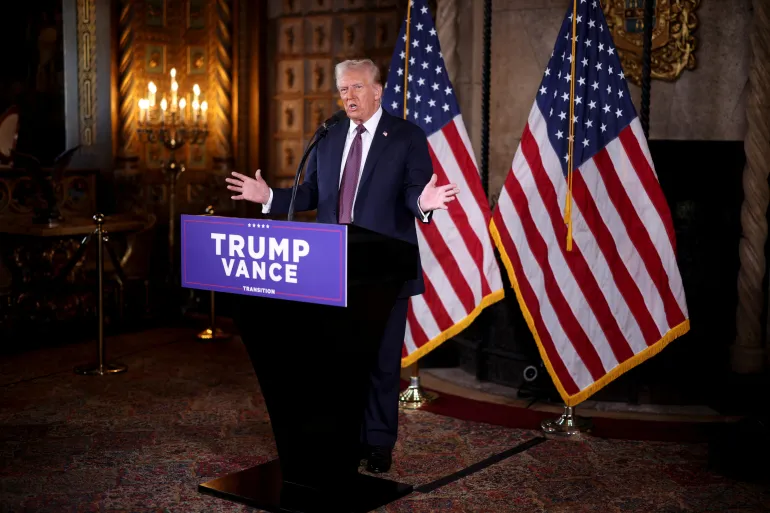They are images woven into the country’s national myth: huddled masses sailing into New York Harbor, drawn by the torch of that “mother of exiles”, the Statue of Liberty, and in more recent decades, families boarding commercial flights as they flee wars and persecution across continents.
But observers say the suspension of the United States refugee programme has turned that national image on its head.
On January 27, the sprawling system the US uses to approve, admit and relocate refugees officially ground to a halt.
The US Refugee Admissions Program (USRAP), the primary arm through which the federal government processes refugee claims, had been placed under an indefinite suspension, by orders of President Donald Trump.
“The United States lacks the ability to absorb large numbers of migrants, and in particular, refugees,” Trump wrote in the executive order authorising the suspension.
In so doing, experts say, Trump has cut to the core of two intersecting questions: how far his presidential power extends and how he could transform the US’s obligations to refugees.
“We’re being exposed to the question of how far can a president go in curtailing a programme that Congress has created,” said Chris Opila, a staff lawyer for the nonprofit American Immigration Council.
The answer could have “severe ramifications” around the world, according to Jaya Ramji-Nogales, an associate dean at Temple University’s Beasley School of Law.
Not only could refugees be left in dangerous conditions, she told Al Jazeera, but Trump’s actions could erode “the values that underlie the programms and the values that it expresses”.
Observers like Ramji-Nogales say the suspension has already damaged the US’s standing abroad.
Just this week, a French politician called for the Statue of Liberty, gifted to the US in 1884, to be returned, citing a betrayal of its values.
The effects of Trump’s January order have been immediate. Thousands of refugees who had already been vetted and approved to enter the US were suddenly stranded.
Among the refugees affected were 10,000 Afghans who had already been approved for travel.
Other groups included families living in crowded refugee camps after fleeing violence in the Democratic Republic of the Congo, and displaced residents of Myanmar seeking safety amid the military-led government’s crackdowns, to name a few.
By definition, refugees are people facing persecution on account of their race, religion, nationality, politics or membership in a particular social group. Their lives often depend on their ability to seek refuge abroad.
To create a system for facilitating those requests, Congress passed the Refugee Act of 1980, which codifies a formal process for admitting and relocating refugees.
The law also specifies that the US refugee system should be “permanent and systemic”, effectively barring unnecessary disruptions in admissions.
The government, it says, is also responsible for providing “comprehensive and uniform provisions for effective resettlement and absorption of those refugees who are admitted”.
But experts say Trump has disrupted that “permanent” system, effectively using his executive authority to subvert the will of Congress.
Fernando Chang-Muy, a professor at the University of Pennsylvania Carey Law School, told Al Jazeera that the legal challenges to Trump’s decision will test the limits of his power.
On the one hand, the court cases could reinforce the balance of powers set out in the US Constitution, wherein the presidency must respect the laws Congress passes.
“The positive that could come out of the legal challenges to Trump’s move is that the first branch of government and the statutes passed by it have to be implemented by the second branch,” Chang-Muy said, referring to Congress and the presidency, respectively.
But that is not the only outcome, Chang-Muy warned. “The negative is it could set a bad precedent that the second branch is more important to the first branch.”
There have been only scant pauses to USRAP in the past, primarily linked to the fear of terrorism.
After the US suffered attacks on September 11, 2001, the administration of then-President George W Bush issued a two-month moratorium on refugee admissions, citing the risk of “terrorists” entering the country.
Then, in 2017, Trump suspended the programme for 120 days shortly after taking office for his first term. He too said the suspension was meant to “protect the nation from terrorist activities by foreign nationals”.
But the risk of “terrorists” exploiting refugee pathways is relatively low — in part because of the thorough vetting refugees must endure.
A 2023 report from the CATO Institute, a libertarian think tank in Washington, DC, analysed the immigration status of so-called terrorists between 1975 and 2022.
It determined that the annual chance of being killed by a refugee in a terrorist attack in the US was one in 3.3 billion.
But the statistical improbability has not blunted concerns about the possibility a bad actor could enter the US through the refugee system.
And the Supreme Court has signalled it is willing to side with broad interpretations of presidential authority in cases of “national security”.
Opila, the lawyer from the American Immigration Council, points to a 2018 case where the Supreme Court ruled “quite broadly — like, very broadly” — in favour of Trump’s ability to curtail refugee admissions.
He had banned travellers from seven Muslim-majority countries, including refugees, on the basis that their admission could “be detrimental to the interests of the United States”.
Critics argued Trump’s ban was discriminatory. But the high court found it had “a legitimate grounding in national security concerns, quite apart from any religious hostility”.
It ruled the “Muslim ban” was allowed to stand, albeit with some changes.








